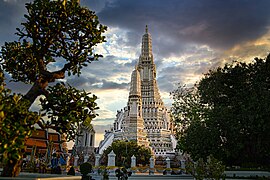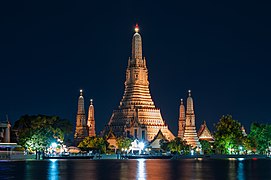Wat Arun
| Wat Arun Ratchawararam | |
|---|---|
Temple of Dawn | |
 The temple, seen from across the river in 2021 | |
| Religion | |
| Affiliation | Theravada Buddhism |
| Location | |
| Country | Thailand |
| Architecture | |
| Completed |
|
| Website | |
| www | |
Wat Arun Ratchawararam Ratchawaramahawihan also known as Wat Chaeng, is a Buddhist temple located in Bangkok, Thailand.[1] It is on Thonburi's west bank of the Chao Phraya River. The temple is known for its stunning architecture and exquisite design. The work on the pagoda started during the reign of Rama III (1824–51). The main prang was completed in 1851, after nine years of continued construction.[2]
History[change | change source]
Wat Arun's story started a long time ago, during the Ayutthaya period. It was previously known as Wat Makok or the Olive Monastery. Later, when King Taksin ruled in the late 1700s, the temple was renovated and given a new name: Wat Chaeng, also known as the Temple of Dawn. The word "Wat Arun" also means "Temple of Dawn." People believe it derives from the Hindu god Aruna, who depicts the sun as it begins to rise.
Cultural Significance[change | change source]
Wat Arun has great cultural and religious importance for Thai people. It is a Buddhist worship and meditation facility that attracts both believers and visitors. The temple is also a well-known emblem of Bangkok, appearing regularly on postcards, paintings, and other works of art.
Architecture[change | change source]
The most notable feature is the tall center prang (a Khmer-style tower), which is encircled by four smaller satellite prangs. These towers symbolize Mount Meru, the revered cosmological center of Buddhist, Hindu, and Jain faiths. The prangs are beautifully embellished with bright porcelain and seashells that were previously used as ballast on ships arriving from China. Visitors can climb steep stairways to the upper platforms of the prangs, which provide panoramic views of the Chao Phraya River and Bangkok. The temple complex also includes the Ordination Hall (Ubosot), which features stunning frescoes, and the Niramitr Buddha image, a golden Buddha figure.
Gallery[change | change source]
-
The prang, seen from within the temple grounds (2020)
-
View of the river from the main prang (2013)
-
The vihara, seen from the main prang (2014)
-
Buddha statues in the cloister (2017)
-
The ordination hall (2018)
-
The principal Buddha image, in the ordination hall (2018)
-
The temple lit up at night (2017)
-
Frontal view of the prang at night (2017)
References[change | change source]
- ↑ "Phraprang Wat Arun Ratchawararam Ratchawora Mahawi". www.tourismthailand.org.
- ↑ ประวัติวัดอรุณราชวราราม ราชวรมหาวิหาร [History of Wat Arun]. watarun.org (in Thai). Retrieved 28 September 2012.









